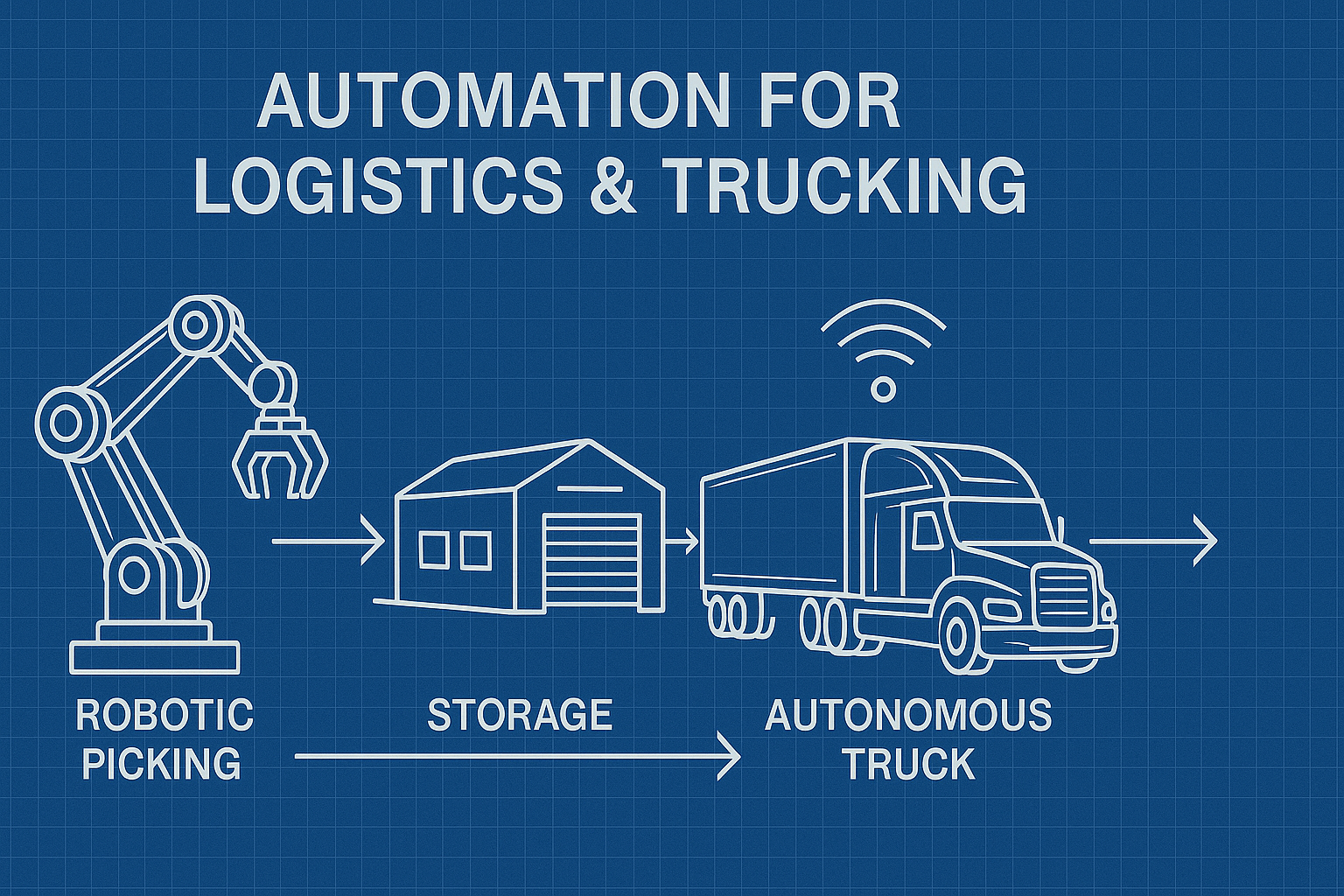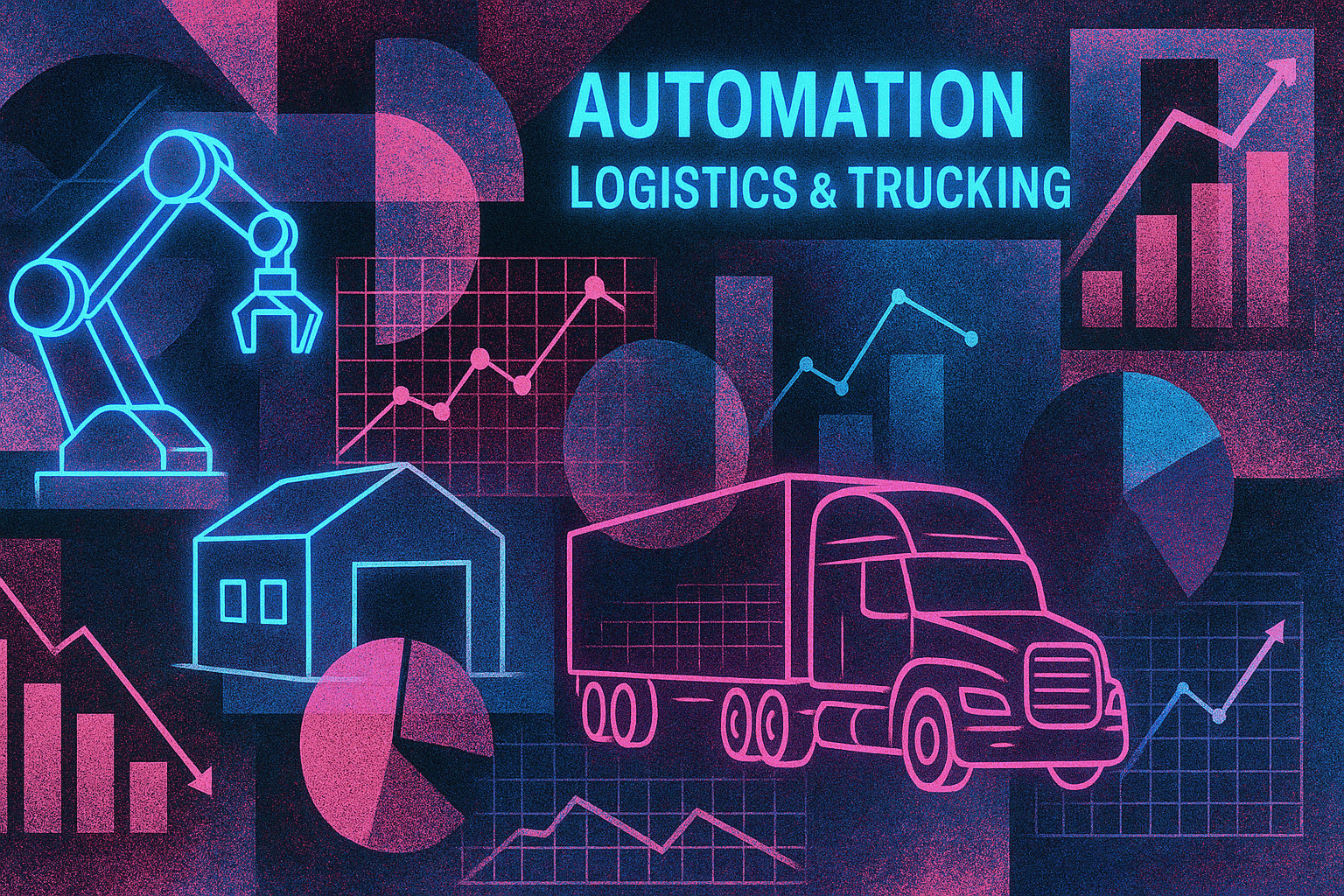Logistics & Trucking Guide to Automation: From Basics to Best-in-Class
by Design Delulu Editorial · October 1, 2025

The logistics and trucking industry operates on razor-thin margins where every minute of delay, every inefficient process, and every manual handoff directly impacts profitability. In an era where customers expect real-time tracking, instant quotes, and seamless communication, companies still relying on spreadsheets, phone calls, and disconnected systems are losing ground to competitors who have embraced intelligent automation. The gap between industry leaders and laggards isn't just technology—it's the systematic elimination of friction at every touchpoint in the supply chain.
Automation for logistics and trucking isn't about replacing human expertise; it's about amplifying it. When route optimization algorithms can process thousands of variables in seconds, when automated load matching connects available capacity with freight in real-time, and when predictive maintenance prevents costly breakdowns before they happen, your team can focus on strategic decisions rather than administrative tasks. This guide breaks down how automation transforms logistics operations from reactive firefighting into proactive, data-driven excellence—with measurable ROI from day one.

Why Automation Matters for Logistics & Trucking
The logistics and trucking sector faces unique operational challenges that make automation not just beneficial, but essential for survival. Driver shortages, fuel price volatility, capacity constraints, and increasing customer demands for transparency create a perfect storm where manual processes simply cannot scale. Companies processing dozens or hundreds of shipments daily find their dispatchers overwhelmed, their customer service teams buried in status inquiries, and their finance departments drowning in invoice reconciliation.
Automation addresses these pain points systematically. Automated dispatch systems can assign loads based on driver hours of service, location proximity, equipment type, and delivery windows—decisions that would take human dispatchers hours to optimize. Electronic logging devices (ELDs) integrated with transportation management systems (TMS) eliminate hours of compliance paperwork while ensuring DOT regulation adherence. Customer portals with real-time tracking reduce "where's my shipment" calls by 70% or more, freeing your team to handle exceptions and build relationships rather than answer routine status questions.
Beyond operational efficiency, automation unlocks strategic advantages. Data from automated systems reveals patterns invisible in manual operations: which lanes are most profitable, which customers consistently cause detention delays, which equipment types deliver the best utilization rates. This intelligence allows you to make pricing decisions based on actual costs, negotiate with shippers from a position of data-backed strength, and identify growth opportunities that competitors miss.
Key Benefits of Automation for Logistics & Trucking
- Real-Time Tracking & Visibility: Automated GPS and IoT sensor integration provides minute-by-minute location data, temperature monitoring for refrigerated loads, and predictive ETAs that automatically update as conditions change. Customers access live dashboards while your operations team identifies delays before they become crises.
- Intelligent Load Matching & Dispatch: Machine learning algorithms analyze historical performance, current capacity, route efficiency, and profitability metrics to recommend optimal load assignments. What once required experienced dispatchers hours of analysis now happens in seconds, with recommendations that improve over time as the system learns your business patterns.
- Automated Documentation & Compliance: From electronic bills of lading to automated IFTA reporting, digital documentation systems eliminate paper trails, reduce errors, and ensure compliance with evolving regulations. Integration with ELDs provides automatic hours-of-service tracking, preventing violations and streamlining DOT audits.
- Predictive Maintenance & Fleet Management: Telematics systems monitor vehicle health in real-time, predicting maintenance needs before breakdowns occur. Automated service scheduling reduces unplanned downtime by up to 40%, extending vehicle life and preventing roadside failures that disrupt operations and damage customer relationships.
- Dynamic Pricing & Revenue Optimization: Automated pricing engines analyze market rates, lane profitability, seasonal demand patterns, and capacity constraints to recommend optimal pricing for each quote. Stop leaving money on the table or pricing yourself out of competitive lanes.
- Streamlined Billing & Payment Processing: Automated invoice generation from load data, integrated with accounting systems, eliminates manual data entry and accelerates cash flow. Automated payment reminders and collections reduce days sales outstanding (DSO) while maintaining positive customer relationships.
- Enhanced Customer Communication: Automated status updates via SMS, email, or API integration keep customers informed without requiring your team to manually send updates. Exception-based alerts ensure your team focuses on problems that need human intervention while routine updates happen automatically.
- Data Analytics & Business Intelligence: Centralized dashboards aggregate data from dispatch, fleet management, accounting, and customer systems into actionable insights. Track KPIs like revenue per mile, deadhead percentage, on-time delivery rates, and customer profitability across your entire operation in real-time.
How Automation Implementation Works
- Discovery & Current State Assessment: We begin by mapping your existing workflows, identifying pain points, and understanding your specific operational constraints. This phase includes stakeholder interviews with dispatchers, drivers, customer service teams, and finance staff to understand where manual processes create bottlenecks. We document current systems, integration points, and data flows to create a comprehensive baseline. Success metrics are defined collaboratively—whether that's reducing dispatch time, improving on-time delivery rates, decreasing detention claims, or accelerating cash collection cycles.
- Automation Blueprint & Architecture Design: Based on discovery findings, we design a phased automation roadmap that prioritizes highest-impact opportunities first. This blueprint specifies which processes to automate, which systems need integration, what data needs to flow between platforms, and how automation will scale as your operation grows. We identify quick wins that can demonstrate ROI within weeks alongside longer-term transformational initiatives. The architecture includes fail-safes and manual overrides to ensure operations continue smoothly if any automated system experiences issues.
- System Selection & Configuration: For each automation component, we evaluate whether existing systems can be enhanced, whether best-in-class third-party solutions should be integrated, or whether custom development is required. Configuration includes setting business rules (e.g., load assignment criteria, pricing algorithms, alert thresholds), establishing user permissions and workflows, and building integrations between previously siloed systems. All configurations are documented for training and future reference.
- Testing, Training & Pilot Deployment: Before full rollout, automated systems undergo rigorous testing with real data in a controlled environment. We identify edge cases, refine business rules, and ensure integrations handle exceptions gracefully. Parallel operations—running both old and new systems simultaneously—validate that automated processes produce correct results. Comprehensive training ensures your team understands not just how to use the systems, but when to override automation and how to interpret the data they provide.
- Launch, Monitor & Optimize: Initial deployment focuses on core workflows with careful monitoring to catch and resolve issues quickly. We establish a feedback loop where users report friction points and opportunities for improvement. Performance metrics are tracked daily during the first weeks, then consolidated into weekly reviews. As patterns emerge, we refine automation rules, adjust thresholds, and expand automation to additional processes. Quarterly strategic reviews assess ROI, identify new automation opportunities, and align technology investments with evolving business priorities.

Core Deliverables for Logistics & Trucking Automation
- Automation Roadmap & Business Case: A prioritized implementation plan that maps automation initiatives to business outcomes, includes cost-benefit analysis for each component, and provides realistic timelines for deployment. This document serves as your blueprint for securing internal buy-in and measuring success.
- System Integration Architecture: Technical specifications for connecting your TMS, ELD, accounting, CRM, and other systems into a cohesive ecosystem where data flows automatically between platforms. Includes API documentation, data mapping, and integration testing protocols.
- Automated Workflow Documentation: Detailed process flows showing how automation handles standard scenarios and exceptions. These documents serve as training materials and operational references, ensuring consistency even as team members change.
- Real-Time Operations Dashboard: Customized dashboards that give dispatchers, operations managers, and executives instant visibility into key metrics. Track active loads, available capacity, driver locations, on-time performance, and exception alerts—all in one unified view that updates in real-time.
- Business Intelligence & Analytics Reports: Automated reports that analyze performance trends, identify profit leaks, benchmark against industry standards, and highlight opportunities for improvement. From lane profitability analysis to customer performance scorecards, these insights drive strategic decision-making.
- Customer Portal & Communication Templates: Self-service portals where customers track shipments, request quotes, and access documentation without contacting your team. Includes automated email and SMS templates for pickup confirmations, in-transit updates, delivery notifications, and exception alerts.
- Training Materials & SOPs: Comprehensive guides, video tutorials, and standard operating procedures that ensure your team can effectively leverage automation tools. Includes quick-reference guides for common scenarios and troubleshooting protocols.
- Performance Metrics & KPI Tracking: Baseline measurements and ongoing tracking of key performance indicators that demonstrate automation ROI. Metrics include time saved, error reduction, cost per transaction, customer satisfaction improvements, and revenue impact.
Best Practices for Logistics & Trucking Automation
- Start with Pain Points, Not Technology: The most successful automation projects begin by identifying specific problems—late deliveries, billing disputes, capacity underutilization—then selecting technology to solve those problems. Avoid the trap of implementing technology for its own sake. When you solve real pain points, ROI is immediate and buy-in is natural.
- Automate Data Entry Before Decision-Making: Many companies rush to implement AI-powered decision engines while their teams still manually enter data. Start by automating data capture—electronic signatures, automatic load updates from tracking, invoice generation from dispatch records. Clean, automated data collection creates the foundation for more sophisticated automation later.
- Design for Exceptions, Not Just Happy Paths: Automation works brilliantly when everything goes according to plan. The real test is how it handles delays, equipment failures, customer changes, and other disruptions. Build exception workflows that alert the right people, provide relevant context, and make it easy to intervene manually when needed.
- Integrate Rather Than Replace: You likely have systems that work well for specific functions—a TMS you've used for years, accounting software your finance team knows inside out, load boards where you find freight. Rather than ripping out these systems, focus on connecting them so data flows automatically. Integration delivers faster ROI with less disruption than wholesale replacement.
- Measure Everything, Optimize Continuously: The beauty of automation is that it generates data about itself. Track how long automated processes take, how often human intervention is needed, where errors occur, and what outcomes improve. Use this data to refine automation rules, streamline workflows, and identify the next processes to automate.
- Train for Understanding, Not Just Button-Pushing: Your team needs to understand what automation is doing and why, not just how to click buttons. When people understand the logic behind automated decisions, they can better judge when to trust the system and when to override it. This understanding also helps them identify opportunities for improvement.
- Build Redundancy and Manual Overrides: Technology fails. Networks go down. APIs stop responding. Ensure every automated process has a manual fallback so operations can continue during outages. Document these procedures and test them regularly so your team is prepared when they're needed.
- Communicate Changes to Customers: When you implement customer-facing automation like tracking portals or automated updates, tell your customers about it. Many will appreciate the improved transparency and self-service capabilities, but they need to know these tools exist and how to use them.
Industry-Specific Strategies for Logistics & Trucking
- Automate Driver Communication Without Losing the Human Touch: Drivers are the backbone of your operation, but they're also on the road, making phone-based communication inefficient. Implement mobile apps that allow drivers to receive assignments, update load status, report issues, and communicate with dispatch—all without taking their attention from the road. Automated pre-trip checklists and digital inspection reports ensure compliance while reducing paperwork.
- Optimize Detention and Accessorial Billing: Detention charges and other accessorials represent significant revenue that many carriers fail to capture because manual tracking and billing is too time-consuming. Automate detention tracking using arrival/departure timestamps from ELDs, automatically generate supporting documentation, and integrate with invoicing to ensure every billable delay gets captured and charged.
- Implement Dynamic Capacity Management: Instead of manually tracking which trucks will be available when and where, automate capacity forecasting based on current load locations, driver hours of service, scheduled maintenance, and historical patterns. This visibility allows sales teams to confidently book loads knowing exact capacity availability, while reducing deadhead miles through better planning.
- Automate Carrier Onboarding and Compliance: For freight brokers and 3PLs, verifying carrier insurance, authority, and safety ratings is critical but time-consuming. Automated carrier compliance monitoring checks FMCSA data, insurance expiration dates, and safety scores continuously, alerting you before a carrier becomes non-compliant. Digital onboarding portals allow new carriers to submit documentation that's automatically verified and stored.
- Create Predictive Load Acceptance Scoring: Analyze historical data to understand which factors predict whether a particular load will be profitable—lane, customer, freight type, timing, equipment requirements. Build automated scoring that flags potentially problematic loads before you accept them, helping your sales team negotiate better rates or decline unprofitable business.
- Streamline Proof of Delivery and Claims Processing: Electronic proof of delivery with photos, signatures, and timestamps eliminates the paper shuffle and provides indisputable documentation. When claims do arise, automated systems can pull delivery records, communication logs, and tracking data instantly, resolving disputes faster and with better outcomes.
- Automate Fuel Tax Reporting (IFTA): IFTA compliance requires tracking miles driven in each jurisdiction—a tedious manual process prone to errors. ELD integration with automated IFTA reporting eliminates the data entry burden while ensuring accuracy that reduces audit risk and potential penalties.
- Implement Intelligent Customer Segmentation: Not all customers are equally profitable. Automate the analysis of customer behavior—on-time pickup/delivery readiness, payment terms adherence, rate consistency, claim frequency—to identify your best customers and those who consume disproportionate resources. Use this intelligence to prioritize capacity allocation and guide pricing negotiations.
Measuring Automation ROI in Logistics & Trucking
Automation investments must deliver measurable business value. The following metrics help you track ROI and identify opportunities for further optimization:
- Operational Efficiency Metrics: Time saved per load dispatched, reduction in manual data entry hours, decrease in phone calls to customer service, reduction in invoice processing time, decrease in dispatch-to-departure time.
- Revenue Metrics: Increase in revenue per truck per week, improvement in load acceptance rates, reduction in deadhead percentage, increase in accessorial revenue capture, improvement in rate per mile through dynamic pricing.
- Cost Reduction Metrics: Decrease in overtime hours, reduction in fuel costs through optimized routing, decrease in maintenance costs from predictive maintenance, reduction in detention penalties paid, decrease in claims and disputes.
- Customer Experience Metrics: Improvement in on-time delivery percentage, reduction in customer service inquiries, increase in customer retention rates, improvement in Net Promoter Score, increase in customer portal adoption and usage.
- Compliance and Risk Metrics: Reduction in DOT violations, improvement in safety scores, decrease in insurance claims, reduction in billing disputes, improvement in audit readiness.
- Asset Utilization Metrics: Increase in truck utilization rates, reduction in empty miles, improvement in trailer-to-tractor ratio, increase in loads per truck per month, improvement in driver retention (as better tools improve job satisfaction).
Common Automation Challenges and Solutions
Implementing automation in logistics and trucking comes with unique challenges. Here's how to address the most common obstacles:
- Challenge: Resistance from experienced staff who prefer familiar manual processes. Solution: Involve these team members early in the automation planning process. Their expertise helps identify what should be automated and what requires human judgment. When they see automation as a tool that makes their job easier rather than a threat to their value, adoption accelerates.
- Challenge: Disparate systems that don't communicate with each other. Solution: Prioritize integration over replacement. Modern APIs and middleware platforms can connect legacy systems without requiring expensive replacements. Start with the highest-value integrations—typically between your TMS and accounting system—to demonstrate quick wins.
- Challenge: Inconsistent data quality that undermines automation accuracy. Solution: Implement data validation rules at the point of entry and automated cleanup processes that standardize formats, correct common errors, and flag anomalies for human review. As data quality improves, automation becomes more reliable.
- Challenge: Drivers and owner-operators resistant to ELDs and mobile technology. Solution: Choose user-friendly tools and emphasize benefits to drivers—automatic logs mean less paperwork, detention tracking helps them get paid for wait time, route optimization gets them home faster. Provide hands-on training and responsive support during the transition.
- Challenge: Customers still wanting to call for status updates despite having access to tracking portals. Solution: Make your portal so good that customers prefer it over calling. Ensure data is accurate and updates are frequent. Proactively send automated updates at key milestones so customers don't need to check. When customers do call, train your team to walk them through the portal rather than just answering the question.
Frequently Asked Questions
Let’s level up your Logistics & Trucking business
Need services that actually move the needle for Logistics & Trucking? See our approach, pricing, and timelines—then book a quick call.
Additional Resources
- Schedule Your Automation Consultation
Book a free 30-minute strategy session to discuss your specific operational challenges, current technology stack, and automation opportunities. We'll provide a preliminary assessment and roadmap tailored to your business goals and budget.
- View Our Logistics & Trucking Portfolio
Explore case studies and success stories from logistics companies and trucking operations that have transformed their business through strategic automation implementation. See real metrics, implementation timelines, and ROI data from companies similar to yours.
- Free Automation Tools & Resources
Access our library of free resources including automation readiness assessments, ROI calculators, process documentation templates, and vendor evaluation frameworks designed specifically for logistics and trucking operations.
Related Reading

Discover how automation for electricians streamlines scheduling, invoicing, lead tracking, and customer follow-ups to boost revenue and efficiency. Get started today.

Discover how automation streamlines furniture & home decor operations with GA4 tracking, attribution modeling, and data-driven dashboards. Get your 90-day implementation roadmap.
